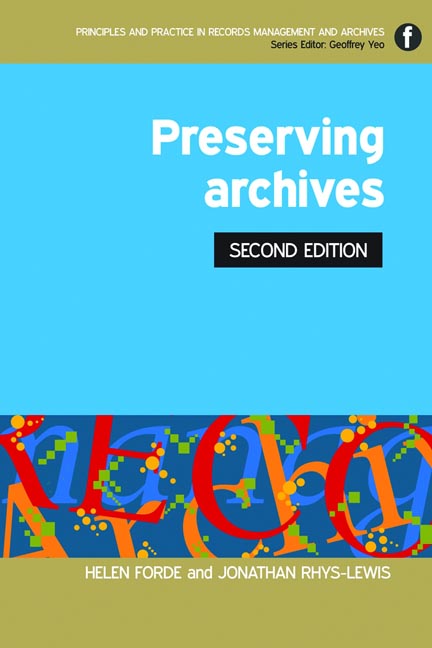Book contents
- Frontmatter
- Contents
- Introduction to the series Geoffrey Yeo
- Preface to the Second Edition
- Acknowledgements
- 1 Introducing archive preservation
- 2 Understanding archival materials and their characteristics
- 3 Managing digital preservation
- 4 Archive buildings and their characteristics
- 5 Safeguarding the building and its contents
- 6 Managing archival storage
- 7 Managing risks and avoiding disaster
- 8 Creating and using surrogates
- 9 Moving the records
- 10 Exhibiting archives
- 11 Handling the records
- 12 Managing a pest control programme
- 13 Training and the use of volunteers
- 14 Putting preservation into practice
- Appendices
- Bibliography
- British and international standards relating to archive preservation
- Index
11 - Handling the records
Published online by Cambridge University Press: 09 June 2018
- Frontmatter
- Contents
- Introduction to the series Geoffrey Yeo
- Preface to the Second Edition
- Acknowledgements
- 1 Introducing archive preservation
- 2 Understanding archival materials and their characteristics
- 3 Managing digital preservation
- 4 Archive buildings and their characteristics
- 5 Safeguarding the building and its contents
- 6 Managing archival storage
- 7 Managing risks and avoiding disaster
- 8 Creating and using surrogates
- 9 Moving the records
- 10 Exhibiting archives
- 11 Handling the records
- 12 Managing a pest control programme
- 13 Training and the use of volunteers
- 14 Putting preservation into practice
- Appendices
- Bibliography
- British and international standards relating to archive preservation
- Index
Summary
Introduction
Archive material rarely handled is likely to remain in reasonable condition, even in an adverse environmental situation. In recent years, however, the rate of deterioration of some materials has increased owing not only to a diminution in the quality of archival materials, but also to increasing use. Visitor numbers at British archives have soared in the last 50 years. Archives and local history centres, previously the preserve of antiquarians and academics, have now become the destination for many seeking information of diverse kinds and are promoted for their seemingly inexhaustible supply.
The desire to promote access is irreproachable: the difficulty comes with the inevitable damage caused to the documents as they are endlessly extracted from storage, taken to a distribution centre or reading room, handed over to the reader and then returned.
Lack of resources to conserve every incoming document to the highest standard leaves the organization with no option but to train both staff and readers in the best ways of preventing further deterioration. This chapter covers:
• ways of encouraging and influencing staff and readers to handle documents carefully
• rules for the readers
• equipment for the reading rooms
• training.
The problem
Each time an original document is accessed by a reader, it is handled at least six times, and that will be in a small repository with few staff. In a larger organization it may be handled up to eight times on each occasion, not including the more detailed, page-by-page perusal by the reader. Archives have to take note of the damage being inflicted, often unwittingly. Much of the paper arrives in the archive already well used and in poor condition (see Figure 11.1). Maps are particularly at risk, often having been out in the field, stuffed into a pocket or traced on a drawing board. Photographs, which have become part of everyday life and are to be found in any archive, are equally at risk. Audiovisual material, tapes and optical discs are just as vulnerable to bad handling and poor care.
Improving the quality of care: how can it be achieved?
Any attempt to improve the quality of care of archives will require a number of different approaches.
- Type
- Chapter
- Information
- Preserving Archives , pp. 175 - 188Publisher: FacetPrint publication year: 2013

